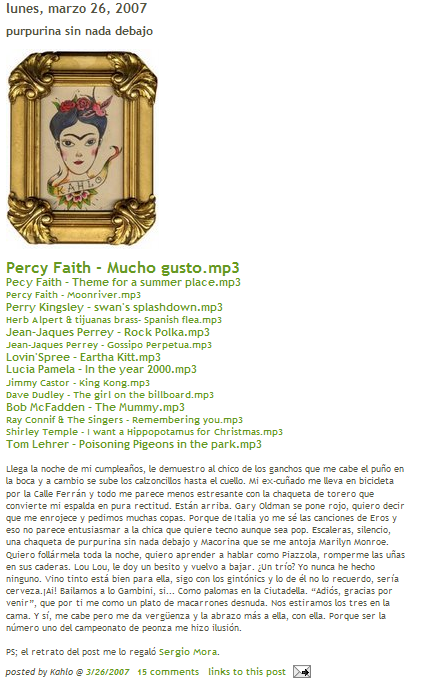I like this moody klankbeeld by Marco Raaphorst.
KlankBeeld Raaphorst: Like a child
Friday, 16 May 2008
Ik heb mijzelf een opdracht gegeven: elke vrijdag een nieuwe compositie op basis van een foto ter inspiratie. Vandaag voor de vierentwintigste keer. KlankBeeld Raaphorst.
Marco_Raaphorst_-_likeachild.mp3Credits:
- Compositie en opname: Marco Raaphorst
- soundtransit CC-BY sample: ‘Children playing in park’ – Olivier Nijs
- CC-BY-NC-ND foto: thephotoholic
hybrid label+blog economics
After I thought more about RCRD LBL‘s economics, I came to a couple conclusions.
I don’t think they’re selling their spots at the listed rates. I think the ads they are selling might be part of package deals with other sites that I don’t know about, because they can’t deliver enough traffic for major brands to pay attention to them. And I think the actual rates are lower.
I also think that I understand their business strategy. They’re able to put major brands inside the world of way-cool MP3 blogging without risking association with copyright infringement. It’s hip but also clean. The business is relying on their squeaky clean copyright status to charge a premium for ads. So even though I don’t think they’re getting the listed rates, I do think they’re getting much better rates than ordinary MP3 blogs.
This points towards an elegant and innovative business model.
Ordinarily internet music companies are forked between two deaths. If they keep it clean they get killed on royalties for licensing. If they’re fast and loose with copyright, they get killed on legal bills and eventually are forced to license anyway. But either problem assumes that they have to carry a broad selection of everything with cultural presence.
RCRD LBL avoids both forks by doing their own A&R, then packaging the results as a blog. The reason they’re a label is that they do their own research work to find obscure gems. It’s important that these are obscure, because it means that licensing costs can be kept down. It’s important that they do their own research, because there aren’t yet strong discovery tools for digging out the gems in the mountain of unknowns. The reason they’re a blog is that they aren’t expected to carry everything everywhere. If they were a search engine like Seeqpod or an encompassing content browser environment like All Music Guide, they would need to carry music that they couldn’t afford to license. The blog format puts them in position to limit what they release.
Note that the importance of lowering royalty costs doesn’t imply that the musicians are getting screwed. If the musicians earn exactly the same as they do on a traditional label, RCRD LBL can still have a winning cost structure by keeping royalties that would normally go to label and publishing bills.
Will it work? It depends on execution. They need to get their traffic up enough to do business with the brand advertisers who will pay a premium for RCRD LBL’s clean but edgy product line. This range is about a million uniques a month.
no singles, please #2
Good bloggers have a warmer and more intimate voice than writers in publications like the New York Times. This applies to musicians as well.
So let’s say that, per yesterday’s post here, we’re moving from a world of albums containing singles to a world where musicians release a series of songs that accumulate like posts in a blog.
You’d expect successful musicians in the new context to have a warmer and more intimate voice. They would let flaws show. They would be avoid grandiose sounds like kettle drums. They would be less physically attractive. They would dress down. They would be quirky.
Old style: Janet Jackson on janetjackson.com – 
New style: Port O’brien on Aquarium Drunkard – 
squashed on standard layout of playlist blogs
Kahlo is posting for MdM and feedmegoodtune is MdM friend as well. (ie. the format you talk is distinct of a tight group of people)There are few more playlist blogs. But overall a regular playlist blog is fairly rare. Almost every big players post at MdM. eg. Music is art is another site. The rest is DJ’s site.
standard layout of playlist blogs
This blog entry catalogs layout patterns in these four playlists:
The following is the standard form of these playlists, in order from top to bottom:
- Date and time the post was created.
- An image related to the mood or theme of the playlist.
- Song list, with each song formatted like this:
- Direct links to mp3s.
- Link text usually formatted as “artist – title”
- Sometimes (2/4 cases) with “(release information)” appended.
- A paragraph or two of prose.
- The traditional footer of a blog post. This usually includes a permalink to the post and the date and time that the post was created.
- Comments on the playlist.
In all cases the blog home page incorporates the full text of the playlist inline rather than linking off to a separate document.

